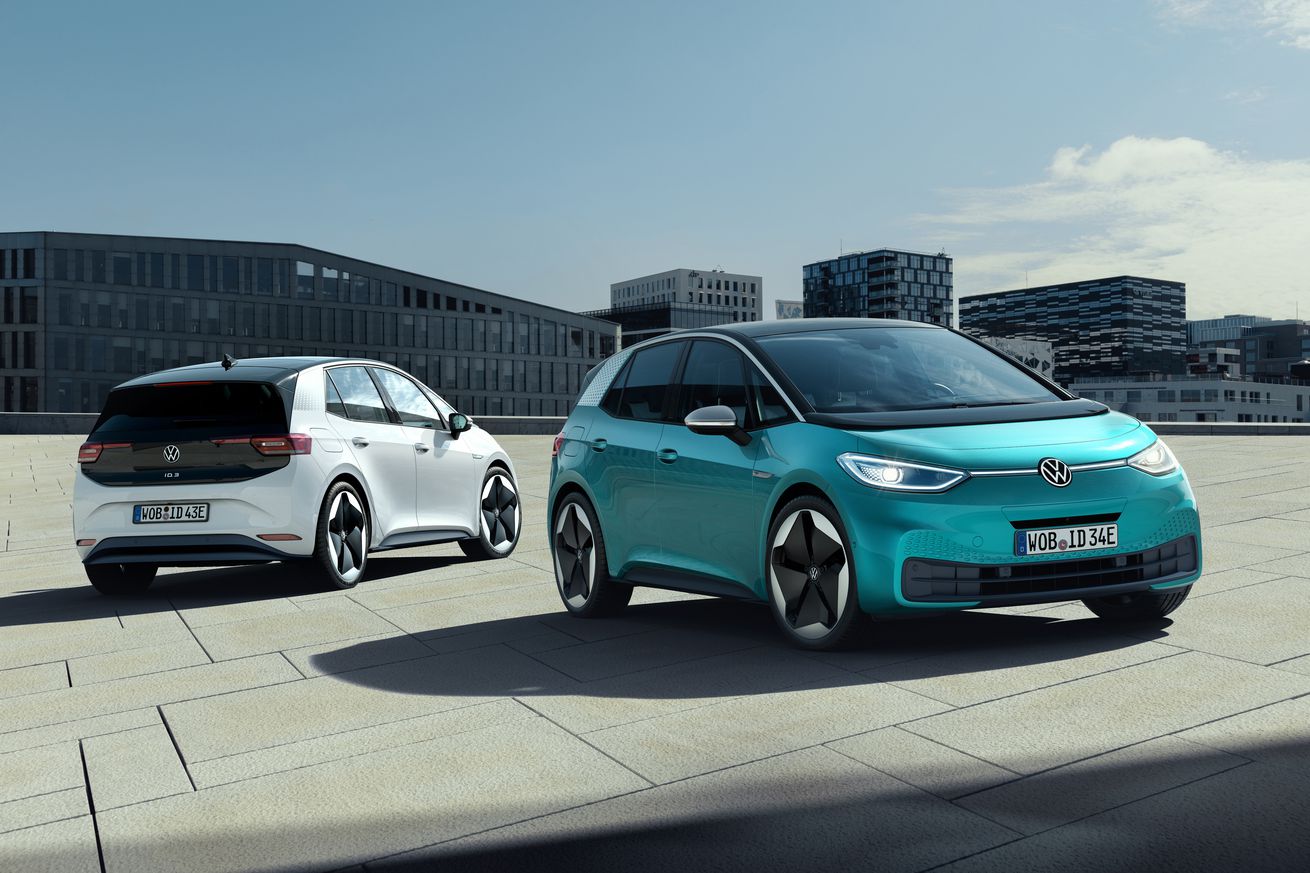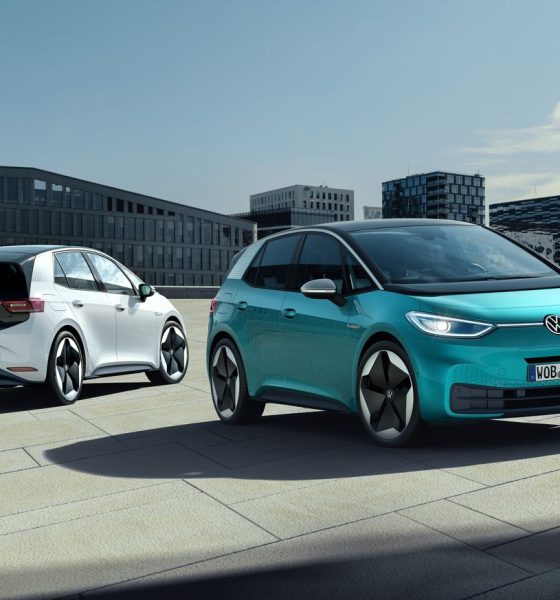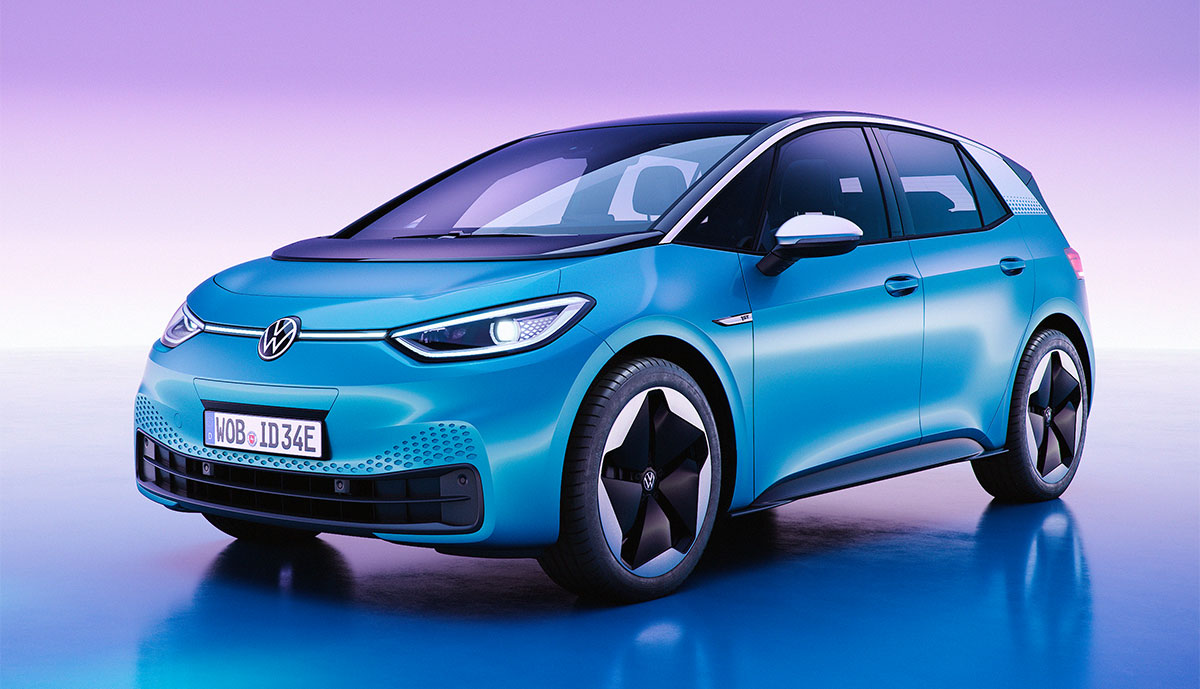

News
Volkswagen calls on ID.3 to boost struggling China EV sales
Volkswagen’s ID.3 all-electric vehicle will make its way to China in Q4 in hopes to harness the momentum from the growing Chinese EV market to boost VW’s lackluster sales in the region.
The German automaker has both the ID.4 crossover and the China-only ID.6 available for purchase currently, but Volkswagen is attempting to push things forward in alignment with their “ACCELERATE” strategy. The ID.3 has performed well in the European market, giving itself a reputation as one of the best-selling EVs in the region since its release in 2020. Now that the ID.3 is being set up for an eventual appearance in China that is currently planned for Q4 2021, Volkswagen is looking to harness more momentum that could help translate its non-impressive sales stats to be on par with region sales leaders Tesla and GM.
(Credit: Volkswagen)
Volkswagen sold 5,800 EVs in July, a drastic increase from its only 2,900 EV sales in June. Despite the relative doubling in sales from June to July, the company is still lagging behind Tesla considerably, which has been one of China’s top 2 EV manufacturers for over a year, sparring with the SAIC-Wuling-GM partnership responsible for the HongGuang Mini EV. The ID.3, with its smaller body style that is more compact and resembles the Golf, could be VW’s golden egg that surges sales and makes the company a competitor in the Chinese market once again.
“Volkswagen’s global electrification offensive is rapidly gaining further momentum. With the ID.3 we are already launching the third all-electric model series in China within a mere six months,” Volkswagen CEO Ralf Brandstätter said. “We are thus underscoring our ambition to occupy a leading position in the market for electric vehicles in China as well as Europe.”
The ID.3 will make its way to the Chengdu Motor Show this week, and customers in China will be able to reserve an ID.3 via a pre-booking system prior to the market launch in October, the company said in a press release. Expectations are outlined by VW as well, which forecasts between 80,000 and 100,000 vehicles from the ID. family will be delivered to customers. This is ultimately dependent on how the company can navigate through the global semiconductor shortage, which could derail delivery plans for several automakers.
“With the ID.4 and ID.6 we have successfully launched two strong model series in recent months. Feedback from our customers is promising, delivery figures meet our expectations,” Volkswagen China CEO Stephan Wöllenstein said. “With the ID.3, we are now offering our customers a product in the important compact segment and, in combination with the other ID. models, are able to cover a large share of the market.”
The expansion of Volkswagen’s EV lineup intends to increase the market share of its fully electric cars in Europe to over 70%. In North America and China, Volkswagen targets an EV share of over 50%.
Volkswagen has not struggled in other markets with its EVs. The company has still managed to deliver around 160,000 units globally this year. The first half of 2021 saw Volkswagen as the leader in European EV registrations with 15.4% of the market share.
What do you think? Let us know in the comments below, or be sure to email me at joey@teslarati.com or on Twitter @KlenderJoey.

News
Tesla FSD fleet is nearing 7 billion total miles, including 2.5 billion city miles
As can be seen on Tesla’s official FSD webpage, vehicles equipped with the system have now navigated over 6.99 billion miles.

Tesla’s Full Self-Driving (Supervised) fleet is closing in on almost 7 billion total miles driven, as per data posted by the company on its official FSD webpage.
These figures hint at the massive scale of data fueling Tesla’s rapid FSD improvements, which have been quite notable as of late.
FSD mileage milestones
As can be seen on Tesla’s official FSD webpage, vehicles equipped with the system have now navigated over 6.99 billion miles. Tesla owner and avid FSD tester Whole Mars Catalog also shared a screenshot indicating that from the nearly 7 billion miles traveled by the FSD fleet, more than 2.5 billion miles were driven inside cities.
City miles are particularly valuable for complex urban scenarios like unprotected turns, pedestrian interactions, and traffic lights. This is also the difference-maker for FSD, as only complex solutions, such as Waymo’s self-driving taxis, operate similarly on inner-city streets. And even then, incidents such as the San Francisco blackouts have proven challenging for sensor-rich vehicles like Waymos.
Tesla’s data edge
Tesla has a number of advantages in the autonomous vehicle sector, one of which is the size of its fleet and the number of vehicles training FSD on real-world roads. Tesla’s nearly 7 billion FSD miles then allow the company to roll out updates that make its vehicles behave like they are being driven by experienced drivers, even if they are operating on their own.
So notable are Tesla’s improvements to FSD that NVIDIA Director of Robotics Jim Fan, after experiencing FSD v14, noted that the system is the first AI that passes what he described as a “Physical Turing Test.”
“Despite knowing exactly how robot learning works, I still find it magical watching the steering wheel turn by itself. First it feels surreal, next it becomes routine. Then, like the smartphone, taking it away actively hurts. This is how humanity gets rewired and glued to god-like technologies,” Fan wrote in a post on X.
News
Tesla starts showing how FSD will change lives in Europe
Local officials tested the system on narrow country roads and were impressed by FSD’s smooth, human-like driving, with some calling the service a game-changer for everyday life in areas that are far from urban centers.

Tesla has launched Europe’s first public shuttle service using Full Self-Driving (Supervised) in the rural Eifelkreis Bitburg-Prüm region of Germany, demonstrating how the technology can restore independence and mobility for people who struggle with limited transport options.
Local officials tested the system on narrow country roads and were impressed by FSD’s smooth, human-like driving, with some calling the service a game-changer for everyday life in areas that are far from urban centers.
Officials see real impact on rural residents
Arzfeld Mayor Johannes Kuhl and District Administrator Andreas Kruppert personally tested the Tesla shuttle service. This allowed them to see just how well FSD navigated winding lanes and rural roads confidently. Kruppert said, “Autonomous driving sounds like science fiction to many, but we simply see here that it works totally well in rural regions too.” Kuhl, for his part, also noted that FSD “feels like a very experienced driver.”
The pilot complements the area’s “Citizen Bus” program, which provides on-demand rides for elderly residents who can no longer drive themselves. Tesla Europe shared a video of a demonstration of the service, highlighting how FSD gives people their freedom back, even in places where public transport is not as prevalent.
What the Ministry for Economic Affairs and Transport says
Rhineland-Palatinate’s Minister Daniela Schmitt supported the project, praising the collaboration that made this “first of its kind in Europe” possible. As per the ministry, the rural rollout for the service shows FSD’s potential beyond major cities, and it delivers tangible benefits like grocery runs, doctor visits, and social connections for isolated residents.
“Reliable and flexible mobility is especially vital in rural areas. With the launch of a shuttle service using self-driving vehicles (FSD supervised) by Tesla in the Eifelkreis Bitburg-Prüm, an innovative pilot project is now getting underway that complements local community bus services. It is the first project of its kind in Europe.
“The result is a real gain for rural mobility: greater accessibility, more flexibility and tangible benefits for everyday life. A strong signal for innovation, cooperation and future-oriented mobility beyond urban centers,” the ministry wrote in a LinkedIn post.
News
Tesla China quietly posts Robotaxi-related job listing
Tesla China is currently seeking a Low Voltage Electrical Engineer to work on circuit board design for the company’s autonomous vehicles.

Tesla has posted a new job listing in Shanghai explicitly tied to its Robotaxi program, fueling speculation that the company is preparing to launch its dedicated autonomous ride-hailing service in China.
As noted in the listing, Tesla China is currently seeking a Low Voltage Electrical Engineer to work on circuit board design for the company’s autonomous vehicles.
Robotaxi-specific role
The listing, which was shared on social media platform X by industry watcher @tslaming, suggested that Tesla China is looking to fill the role urgently. The job listing itself specifically mentions that the person hired for the role will be working on the Low Voltage Hardware team, which would design the circuit boards that would serve as the nervous system of the Robotaxi.
Key tasks for the role, as indicated in the job listing, include collaboration with PCB layout, firmware, mechanical, program management, and validation teams, among other responsibilities. The role is based in Shanghai.
China Robotaxi launch
China represents a massive potential market for robotaxis, with its dense urban centers and supportive policies in select cities. Tesla has limited permission to roll out FSD in the country, though despite this, its vehicles have been hailed as among the best in the market when it comes to autonomous features. So far, at least, it appears that China supports Tesla’s FSD and Robotaxi rollout.
This was hinted at in November, when Tesla brought the Cybercab to the 8th China International Import Expo (CIIE) in Shanghai, marking the first time that the autonomous two-seater was brought to the Asia-Pacific region. The vehicle, despite not having a release date in China, received a significant amount of interest among the event’s attendees.








